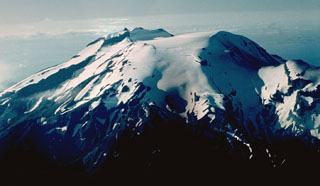Report on Calbuco (Chile) — 29 April-5 May 2015
Smithsonian Institution / US Geological Survey
Weekly Volcanic Activity Report, 29 April-5 May 2015
Managing Editor: Sally Sennert.
Please cite this report as:
Global Volcanism Program, 2015. Report on Calbuco (Chile) (Sennert, S, ed.). Weekly Volcanic Activity Report, 29 April-5 May 2015. Smithsonian Institution and US Geological Survey.
Calbuco
Chile
41.33°S, 72.618°W; summit elev. 1974 m
All times are local (unless otherwise noted)
OVDAS-SERNAGEOMIN reported that on 29 April a weak ash plume rose as high as 1.5 km above Calbuco and seismicity remained stable. An event that began at 1308 on 30 April produced an ash plume that rose 3-5 km and drifted SE. A small lahar in the Blanco River may have been caused by a pyroclastic flow. Tremor amplitude increased and became sustained after the event. On 2 May the number of earthquakes increased. Seismicity significantly increased on 3 May, characterized by a swarm of volcano-tectonic events, and then decreased afterwards. Seismicity was low and stable on 5 May. A plume rose less than 1 km during 1-3 May; cloud cover prevented visual observations of the volcano during 4-5 May. According to ONEMI, the number of evacuees totaled 6,685 on 5 May. The Alert Level remained at Red (the highest level on a four-color scale).
Geological Summary. Calbuco is one of the most active volcanoes of the southern Chilean Andes, along with its neighbor, Osorno. The late-Pleistocene to Holocene andesitic volcano is immediately SE of Lake Llanquihué in the Chilean lake district. Guanahuca, Guenauca, Huanauca, and Huanaque, all listed as synonyms of Calbuco (Catalog of Active Volcanoes of the World), are actually synonyms of nearby Osorno volcano (Moreno 1985, pers. comm.). The edifice is elongated in a SW-NE direction and is capped by a 400-500 m wide summit crater. The complex evolution included collapse of an intermediate edifice during the late Pleistocene that produced a 3-km3 debris avalanche that reached the lake. It has erupted frequently during the Holocene, and one of the largest historical eruptions in southern Chile took place from Calbuco in 1893-1894 that concluded with lava dome emplacement. Subsequent eruptions have enlarged the lava-dome complex in the summit crater.
Sources: Servicio Nacional de Geología y Minería (SERNAGEOMIN), Oficina Nacional de Emergencia-Ministerio del Interior (ONEMI)

